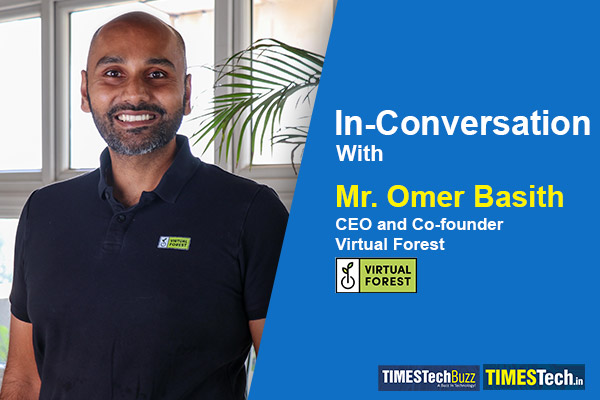In an exclusive interview with Omer Basith, CEO and Co-founder of Virtual Forest, we delve into the company’s mission to transform India’s electronics manufacturing sector. Discover how Virtual Forest is driving innovation, sustainability, and ‘Make in India’ goals through its cutting-edge motor control electronics and visionary approach to the industry’s future.
Read the full interview here:
TimesTech: Can you briefly talk about Virtual Forest & its offerings?
Mr. Omer: We specialise in motor control electronics & human interface technologies for the consumer appliance and electric mobility ecosystem. We provide a unique category of service that gives the Indian consumer electronics ecosystem access to world-class Original Design Manufacturing Services (ODM) while avoiding the high-cost lengthy process of application of new technologies and capacity creation.
Virtual Forest gives its customers a unique design and manufacturing experience – hand holding them in the absence of design requirements, providing in-house domain expertise, and helping them walk the journey from R&D all the way to mass manufacturing. We want to make India the hotspot of electronics manufacturing by becoming the go-to partner for leading Original Equipment Manufacturers (OEMs).
Virtual Forest is trying to address a major gap in the electronics ecosystem, which is lack of R&D and huge dependence on imports. The company is trying to build a local supply chain of critical electronic components by designing & developing motor controllers in-house (local IP creation). A lot of OEM players are highly dependent on neighbouring countries like China or Vietnam for these components. The government is also trying to build a domestic supply chain of electronics manufacturing to cut down on imports and position India as a manufacturing powerhouse. Schemes like PLI, PMP, FAME are all steps in that direction. Our vision is to capture the value of licence costs (involving high margins) in electronics manufacturing on Indian soil. As of now, we are largely assembling and testing finished products and the initial stages of the supply chain are completely outsourced. The market is filled with vendors who are just buying and selling outsourced electronic components. We are trying to change that by specialising in ESDM (Electronics System Design & Manufacturing) capabilities – which is seriously lacking in the ecosystem currently.
TimesTech: How Virtual Forest is contributing to India’s sustainability goals?
Mr. Omer: Carbon, energy and money have become interchangeable. So, we may assume preventing emissions from entering the atmosphere has the same net effect as removing emissions from the atmosphere (in reality, emissions prevented have a considerably more positive impact than emission sequestered).
A Watt saved = CO2 avoided = Rupees saved
This is the thesis behind the existence of Virtual Forest. We have identified motor control electronics for energy efficient appliances and electric mobility as our first focus area. Home appliances and EVs all require motors and our motor controllers present a low carbon pathway with a demonstrated ROI that has the potential to deliver real world energy savings of up to 40%. Our ambition is to help mitigate 6.16 megatons of CO2/year by creating a supply of energy efficient electronics for inverter AC’s, BLDC ceiling fans, fluid movement pump controllers, inverter washing machines, three-wheeler electric vehicles and more. Another way of capturing this number is to say we are building a ‘Virtual Forest’ the size of the Sundarbans National Park (roughly 1332 Km of forest cover or 33 million fully grown trees).
TimesTech: In your opinion, how hardware tech can solve the climate change issue?
Mr. Omer: In the rapidly evolving landscape of green technology, hardware technology emerges as a pivotal force, capable of reshaping industries and steering them towards sustainability.
Like with energy, innovations in hardware can play a big role in achieving net zero. Economical insulation methods and advancements in thermal technologies can improve heating and cooling efficiencies in homes. If these technologies are extrapolated in industrial settings, that can contribute to decreased energy consumption. Furthermore, continued electrification in transportation will open doors for clean power sources like hydro, wind, solar and nuclear. Government policies that enforce energy efficiency and support (in terms of subsidies) the easy deployment of these technologies will lead to a cultural shift in adopting clean energy sources. Virtual Forest’s energy-efficient motor controllers exemplify this potential.
TimesTech: What has been the business growth been like in terms of revenue, operations or employee count?
Mr. Omer: Our core metric is GMV (gross manufacturing value) which is the total value of PCBA’s (Printed Circuit Board Assembly) manufactured using our designs. For FY 22-23, our GMV growth was 165%. We have four types of motor controllers in the mass production stage and seven are in the development stage. The current employee headcount is 33 with close to 25 of them in R&D. In a short span of time, we have forged incredible partnerships with blue chip companies like Napino Auto, Redler Technologies NXP, Arrow Electronics etc. We also have big OEM customers like IFB, Voltas, Luminous, Crompton, Bluestar, etc.
TimesTech: In line with the government’s vision of ‘Make in India’, where do you think we are headed and what more can be done to achieve the desired goals?
Mr. Omer: We are definitely making great strides towards the government’s vision of ‘Make in India’. In the case of electronics, the rising consumption of electronics coupled with the government’s mission to achieve USD 300 Billion of domestic electronics manufacturing has spurred the growth of global and homegrown startups. Key drivers behind this trend are:
- India’s growing digital economy and changing lifestyle choices are increasing the demand for smartphones, laptops, and other electronics products.
- Electronic and mobile companies are capitalising on the opportunities in the manufacturing space and they have the first-mover advantage
- Government has significantly invested in providing subsidies and upgrading infrastructure to attract manufacturing units and their subsidiaries
- Public private partnerships have made available a skilled pool of talent required by electronics manufacturers
While the progress has been good, certain measures can help in achieving the mission on time. So far, India’s focus has been on boosting the assembling capacity but moving forward the next phase should focus on localising the entire value chain in the country to reap higher margins and strengthen our manufacturing capabilities further. The government should also encourage more Indian firms which are working in niche areas of designing and manufacturing critical electronic subcomponents.
TimesTech: What are your future plans?
Mr. Omer: The company’s GMV in the last financial year was 11.5 Mn dollars and now we are targeting a GMV in excess of USD 37 Mn in the current financial year. It is our target to close 400 Mn dollars of GMV by 2026-27. The objective is to play a major part in the growth story of the Indian electronics industry, through creation of electronics IP in growing segments like electric mobility, air conditioning and other home appliances. We have created a roadmap to achieve our growth targets and are positive about achieving them.















